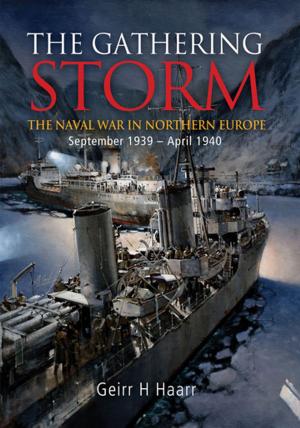Strike Warfare
An Introduction to Non-Nuclear Attack by Air and Sea
Nonfiction, History, Military, Naval| Author: | Dale E. Knutsen | ISBN: | 9781612510965 |
| Publisher: | Naval Institute Press | Publication: | March 20, 2012 |
| Imprint: | Naval Institute Press | Language: | English |
| Author: | Dale E. Knutsen |
| ISBN: | 9781612510965 |
| Publisher: | Naval Institute Press |
| Publication: | March 20, 2012 |
| Imprint: | Naval Institute Press |
| Language: | English |
Strike warfare is a term that is rarely used in the popular media even though reports of conflicts often describe its application or effects. Those brief snippets of information seldom provide a complete picture of what is happening at the time, and they almost never explain the operational or technical background that influences how such actions occur. This leaves the average reader or viewer with an information void, a gap in understanding.
This book is intended to fill that gap. It does so in a logical and methodical fashion, building the picture piece by piece using easily understandable language. It begins with a discussion of the more newsworthy side of the subject, strike warfare operations. All of the key elements are addressed: targets, defenses, resources, and the several steps required to prosecute an attack. The book’s goal is to eliminate the uncertainty, the mystery and the outright fiction that sometimes exists in popular versions of the story.
The second half of the book deals with an even less understood part of the subject, the development of strike weapons. The average citizen may occasionally hear of cost overruns, development test failures or some other negative aspect of military development programs, but there is hardly any background information available to the American taxpayer on how such programs function in general.
Again, the book aims to correct a deficiency with respect to an accurate account of how strike weapons are actually developed. The entire development and life cycle is described, step by step, at the summary level. The author then closes with some thoughts about lessons learned and trends for the future.
This is recommended reading for anyone with an interest in or a connection with strike warfare or strike weapons development. It should prove helpful to military or civilian newcomers to the field, members of the news media, and legislators or members of their staff dealing with military matters. But first and foremost, it was written to provide the average American taxpayer a better understanding of an important and powerful military capability.
This book is intended to fill that gap. It does so in a logical and methodical fashion, building the picture piece by piece using easily understandable language. It begins with a discussion of the more newsworthy side of the subject, strike warfare operations. All of the key elements are addressed: targets, defenses, resources, and the several steps required to prosecute an attack. The book’s goal is to eliminate the uncertainty, the mystery and the outright fiction that sometimes exists in popular versions of the story.
The second half of the book deals with an even less understood part of the subject, the development of strike weapons. The average citizen may occasionally hear of cost overruns, development test failures or some other negative aspect of military development programs, but there is hardly any background information available to the American taxpayer on how such programs function in general.
Again, the book aims to correct a deficiency with respect to an accurate account of how strike weapons are actually developed. The entire development and life cycle is described, step by step, at the summary level. The author then closes with some thoughts about lessons learned and trends for the future.
This is recommended reading for anyone with an interest in or a connection with strike warfare or strike weapons development. It should prove helpful to military or civilian newcomers to the field, members of the news media, and legislators or members of their staff dealing with military matters. But first and foremost, it was written to provide the average American taxpayer a better understanding of an important and powerful military capability.
Strike warfare is a term that is rarely used in the popular media even though reports of conflicts often describe its application or effects. Those brief snippets of information seldom provide a complete picture of what is happening at the time, and they almost never explain the operational or technical background that influences how such actions occur. This leaves the average reader or viewer with an information void, a gap in understanding.
This book is intended to fill that gap. It does so in a logical and methodical fashion, building the picture piece by piece using easily understandable language. It begins with a discussion of the more newsworthy side of the subject, strike warfare operations. All of the key elements are addressed: targets, defenses, resources, and the several steps required to prosecute an attack. The book’s goal is to eliminate the uncertainty, the mystery and the outright fiction that sometimes exists in popular versions of the story.
The second half of the book deals with an even less understood part of the subject, the development of strike weapons. The average citizen may occasionally hear of cost overruns, development test failures or some other negative aspect of military development programs, but there is hardly any background information available to the American taxpayer on how such programs function in general.
Again, the book aims to correct a deficiency with respect to an accurate account of how strike weapons are actually developed. The entire development and life cycle is described, step by step, at the summary level. The author then closes with some thoughts about lessons learned and trends for the future.
This is recommended reading for anyone with an interest in or a connection with strike warfare or strike weapons development. It should prove helpful to military or civilian newcomers to the field, members of the news media, and legislators or members of their staff dealing with military matters. But first and foremost, it was written to provide the average American taxpayer a better understanding of an important and powerful military capability.
This book is intended to fill that gap. It does so in a logical and methodical fashion, building the picture piece by piece using easily understandable language. It begins with a discussion of the more newsworthy side of the subject, strike warfare operations. All of the key elements are addressed: targets, defenses, resources, and the several steps required to prosecute an attack. The book’s goal is to eliminate the uncertainty, the mystery and the outright fiction that sometimes exists in popular versions of the story.
The second half of the book deals with an even less understood part of the subject, the development of strike weapons. The average citizen may occasionally hear of cost overruns, development test failures or some other negative aspect of military development programs, but there is hardly any background information available to the American taxpayer on how such programs function in general.
Again, the book aims to correct a deficiency with respect to an accurate account of how strike weapons are actually developed. The entire development and life cycle is described, step by step, at the summary level. The author then closes with some thoughts about lessons learned and trends for the future.
This is recommended reading for anyone with an interest in or a connection with strike warfare or strike weapons development. It should prove helpful to military or civilian newcomers to the field, members of the news media, and legislators or members of their staff dealing with military matters. But first and foremost, it was written to provide the average American taxpayer a better understanding of an important and powerful military capability.















